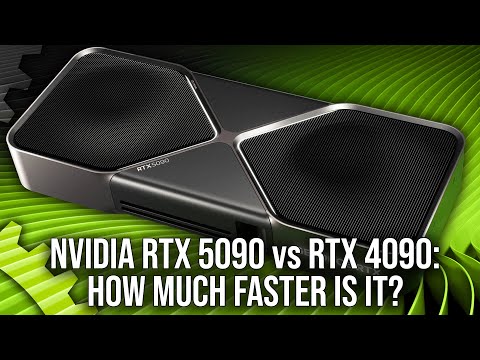Nvidia GeForce RTX 5090 review: the new fastest gaming GPU
The Founders Edition delivers exceptional performance in an impossibly small form factor.
Nvidia's RTX 50-series "Blackwell" graphics cards arrive with this, the RTX 5090. At $2000/£1940, this is an extremely expensive proposition, but it makes some alluring promises in return: best-ever gaming performance from the GB202 GPU, 32GB of high-speed GDDR7 memory for games or content creation, and DLSS 4 with multi frame generation to max out almost any monitor's maximum refresh rate in supported games. Does it deliver?
To find out, we've tested the RTX 5090 Founders Edition in our new suite of challenging titles, looking at RT and raster performance across a range of resolutions and in some of the most demanding scenes we've identified from our tech reviews of PC games, many with custom benchmark runs exclusive to Digital Foundry.
Before we get into the benchmark results, let's cover off the physical design of the card itself, our performance expectations based on its specs and how we'll be testing it.
It's immediately apparent that this Nvidia Founders Edition model is by far the most compact flagship card we've seen from Team Green in years, with a two-slot design that actually fits into small form factor PCs despite drawing a rated 575W. That magic trick is achieved through a centralised PCB and two flow-through fans, which draw air straight through two impressively dense fin stacks and out the other side. It's an astonishing piece of industrial design.
Third-party cards from Nvidia's partners are expected to tread more familiar ground, with the more customary triple-fan, triple-fan designs, so the Founders Edition model could be even harder to find than usual. (We've rounded up the UK and US RTX 5090 retailers with listings for bookmarking purposes if needed.)
Either way, you can expect hefty power delivery, with the FE card requiring a 600W 12V-2x6 power cable, which can be attached directly from compatible ATX 3.0+ PSUs or connected to four 8-pin PCIe cables using the adapter provided. This is angled on the FE card, to prevent undue strain on the cable, while the revised connector ought to prevent the charring we experienced on one RTX 4090 FE unit. As well as the usual HDMI 2.1 port, there are three DisplayPort 2.1 ports, allowing for compatible 4K 240Hz HDR displays to be connected without the need for DSC (display stream compression).
| Nvidia | RTX 5090 | RTX 5080 | RTX 5070 Ti | RTX 5070 |
|---|---|---|---|---|
| GPU | GB202 | GB203 | GB203 | GB205 |
| Cores | 21760 | 10752 | 8960 | 6144 |
| Boost clock | 2.41GHz | 2.62GHz | 2.45GHz | 2.51GHz |
| Tensor core TOPS | 3352 | 1801 | 1406 | 988 |
| RT core TFLOPS | 318 | 171 | 133 | 94 |
| Memory | 32GB GDDR7 | 16GB GDDR7 | 16GB GDDR7 | 12GB GDDR7 |
| Memory bus width | 512-bit | 256-bit | 256-bit | 192-bit |
| Memory bandwidth | 1792GB/s | 960GB/s | 896GB/s | 672GB/s |
| Total Graphics Power | 575W | 360W | 300W | 250W |
| PSU recommendation | 1000W | 850W | 750W | 650W |
| Power connector | 600W PCIe 5.0 (4x 8-pin) | 450W PCIe 5.0 (3x 8-pin) | 300W PCIe 5.0 (2x 8-pin) | 300W PCIe 5.0 (2x 8-pin) |
| Price | $1999/£1939 | $999/£979 | $749/£729 | $549/£539 |
| Release Date | January 30th | January 30th | February | February |
In terms of specs, we're looking at 21,760 CUDA cores, rated boost clocks of 2.41GHz and 1792GB/s of memory bandwidth, with that 32GB of GDDR7 attached via a super-wide 512-bit bus. That translates into fairly substantial gains versus the RTX 4090 FE, which has "only" 16,384 CUDA cores and a 384-bit memory interface good for 1018GB/s of bandwidth, though that card did run at even higher boost clocks of 2.52GHz. That means a 33 percent increase in GPU cores, a 77 improvement in memory bandwidth and a 28 percent increase in power consumption.
Most of Nvidia's marketing materials regarding the 5090 versus the 4090 have focused on comparisons with multi frame generation versus single frame generation, so it'll be fascinating to see how the two flagship cards card in true apples-to-apples tests. We'd expect something in the range of 25 to 35 percent should be possible, looking at the spec differences, but there are plenty of complications that could shift the results one way or another.
For all of our results, we're using a top-end system based around the fastest gaming CPU, the AMD Ryzen 7 9800X3D, to shift the burden to the graphics card as much as possible. We also have 32GB of Trident Z5 Neo DDR5-6000 CL30 memory, a high-end Asus ROG Crosshair X870E Hero motherboard and a 1000W Corsair PSU.
With all that said, let's get into the benchmarks.
Nvidia GeForce RTX 5090 Analysis
- Introduction [This Page]
- RT benchmarks: Alan Wake 2, Avatar: Frontiers of Pandora, Cyberpunk 2077
- RT benchmarks: Dying Light 2, F1 24, Hitman: World of Assassination
- RT benchmarks: Indiana Jones and the Great Circle, Metro Exodus Enhanced Edition, A Plague Tale: Requiem
- Game benchmarks: Alan Wake 2, Black Myth: Wukong, Cyberpunk 2077
- Game benchmarks: F1 24, Forza Horizon 5, Senua's Saga: Hellblade 2
- Game benchmarks: Hitman: World of Assassination, A Plague Tale: Requiem
- Conclusions, value and recommendations


